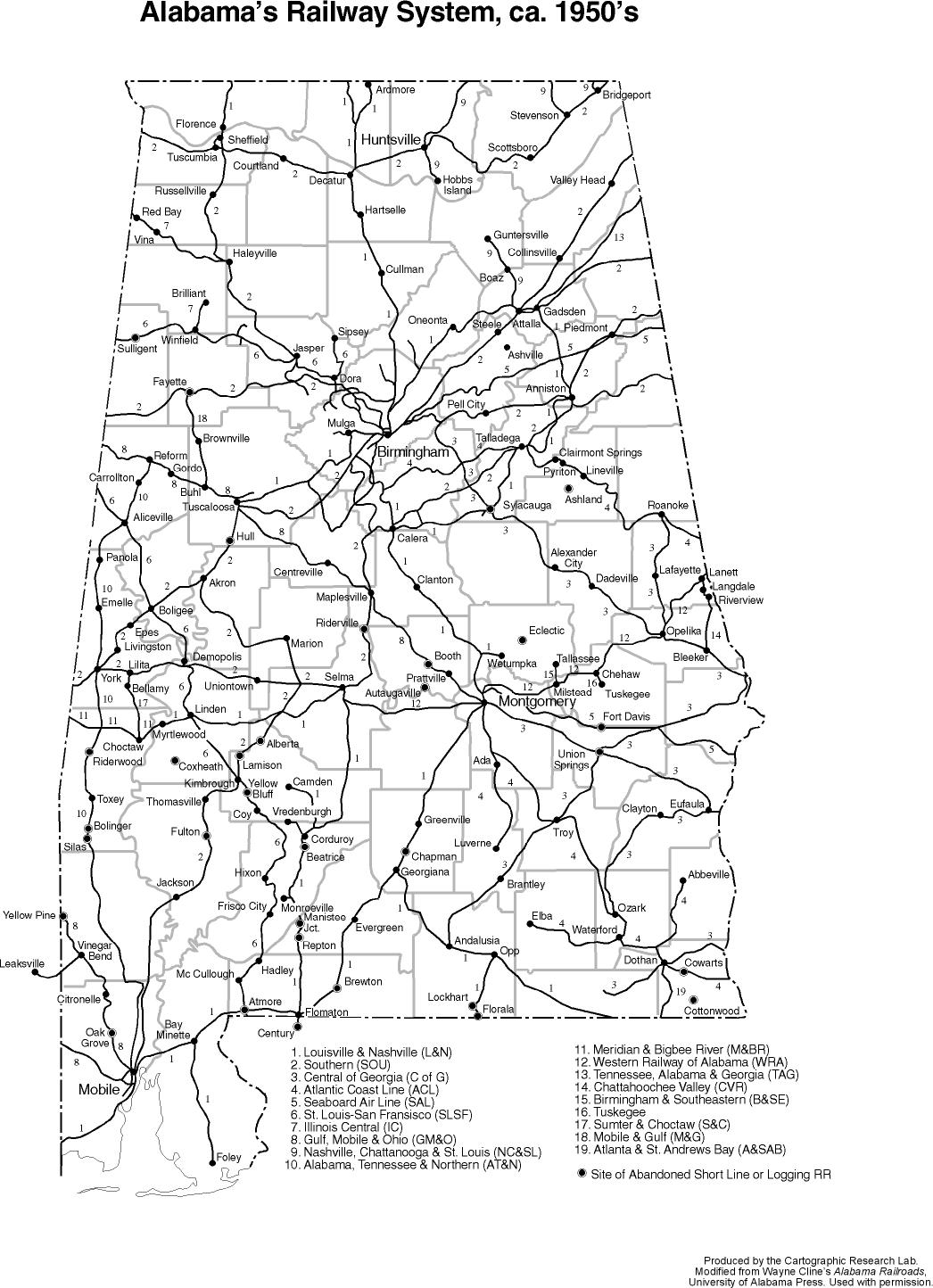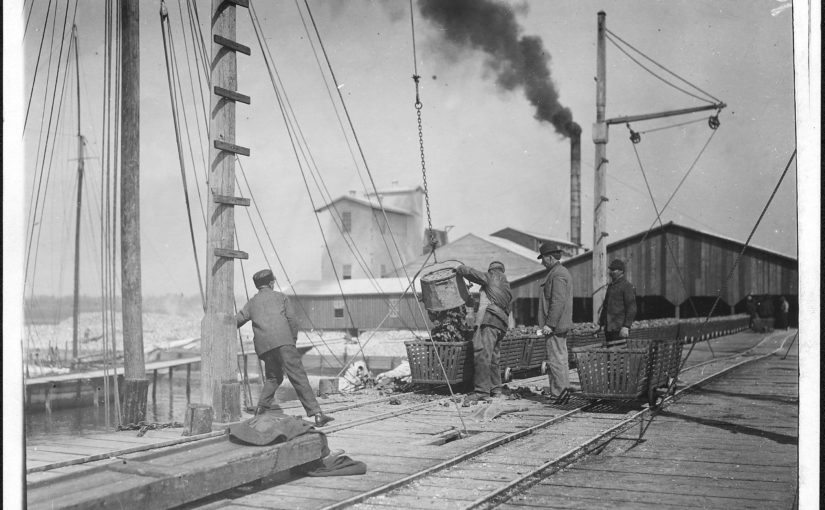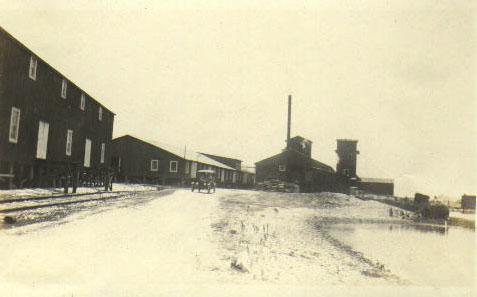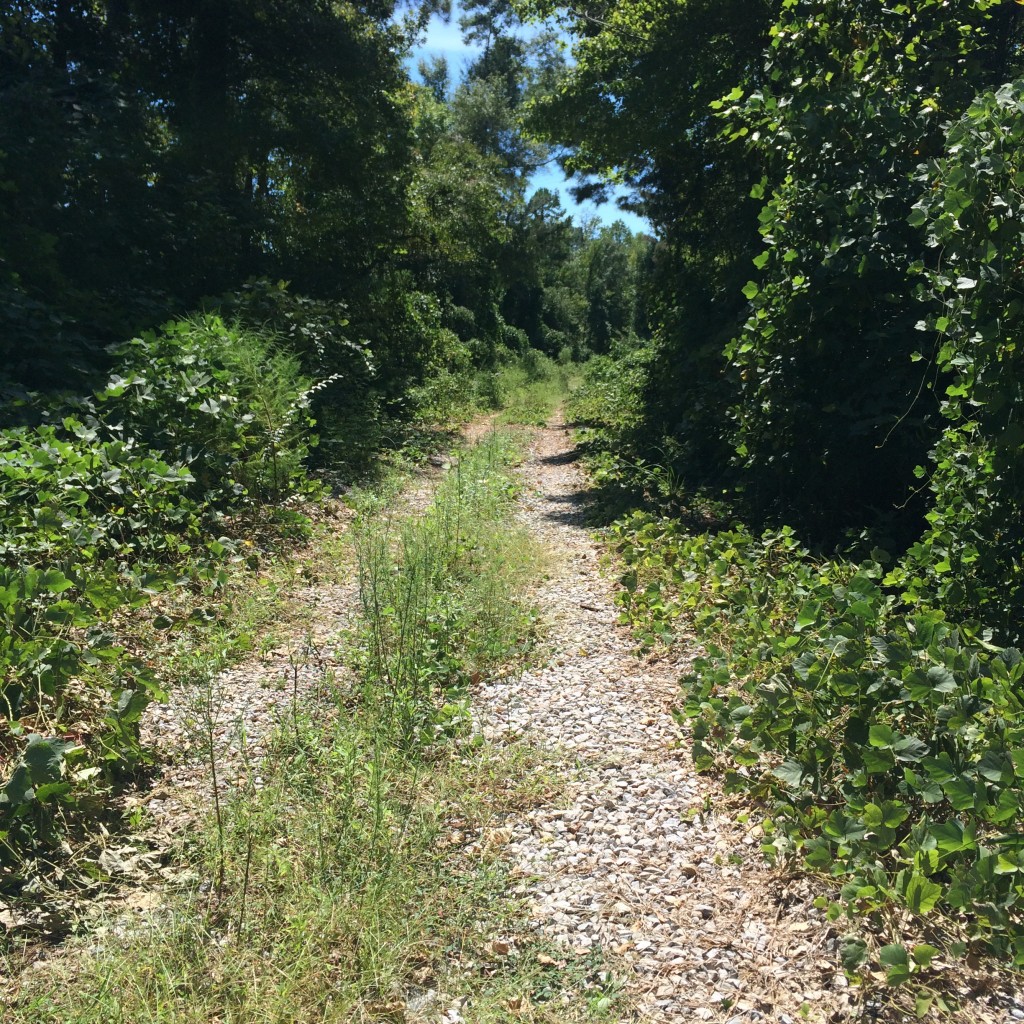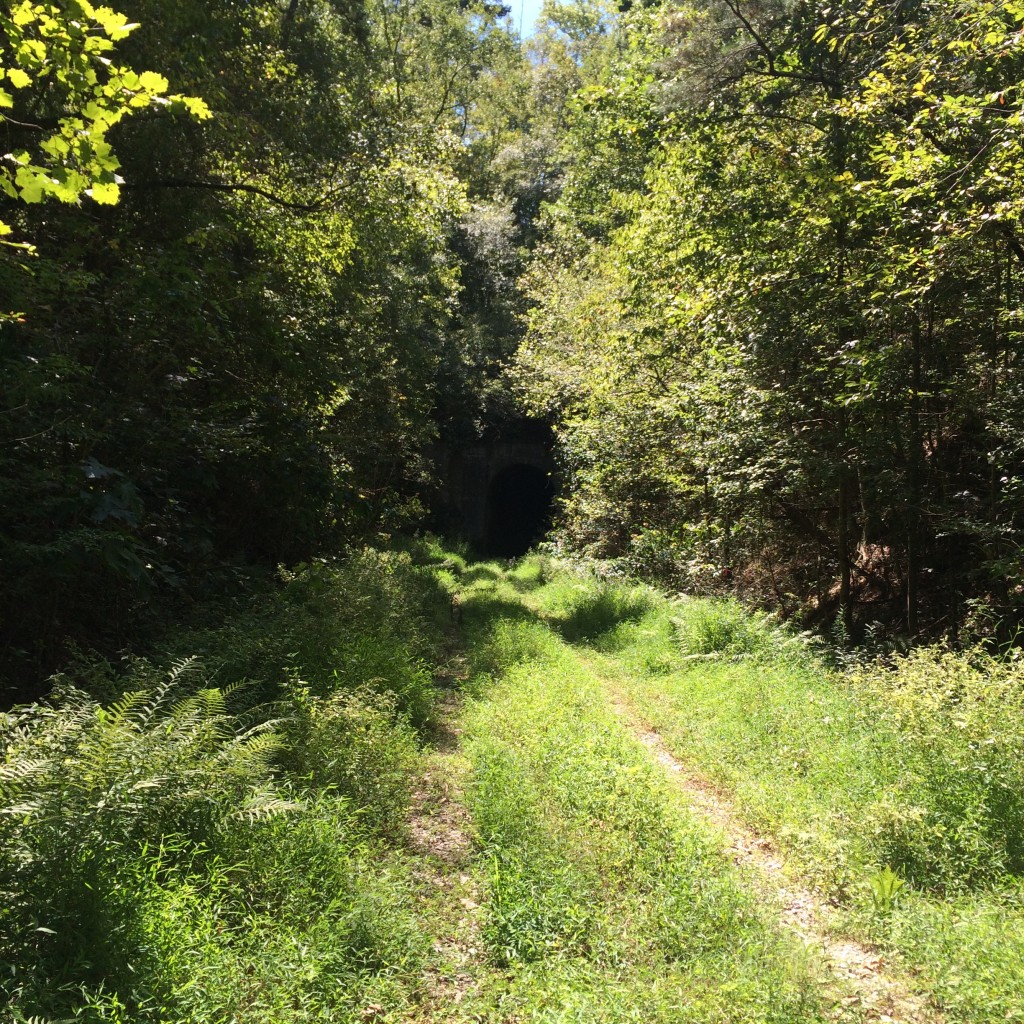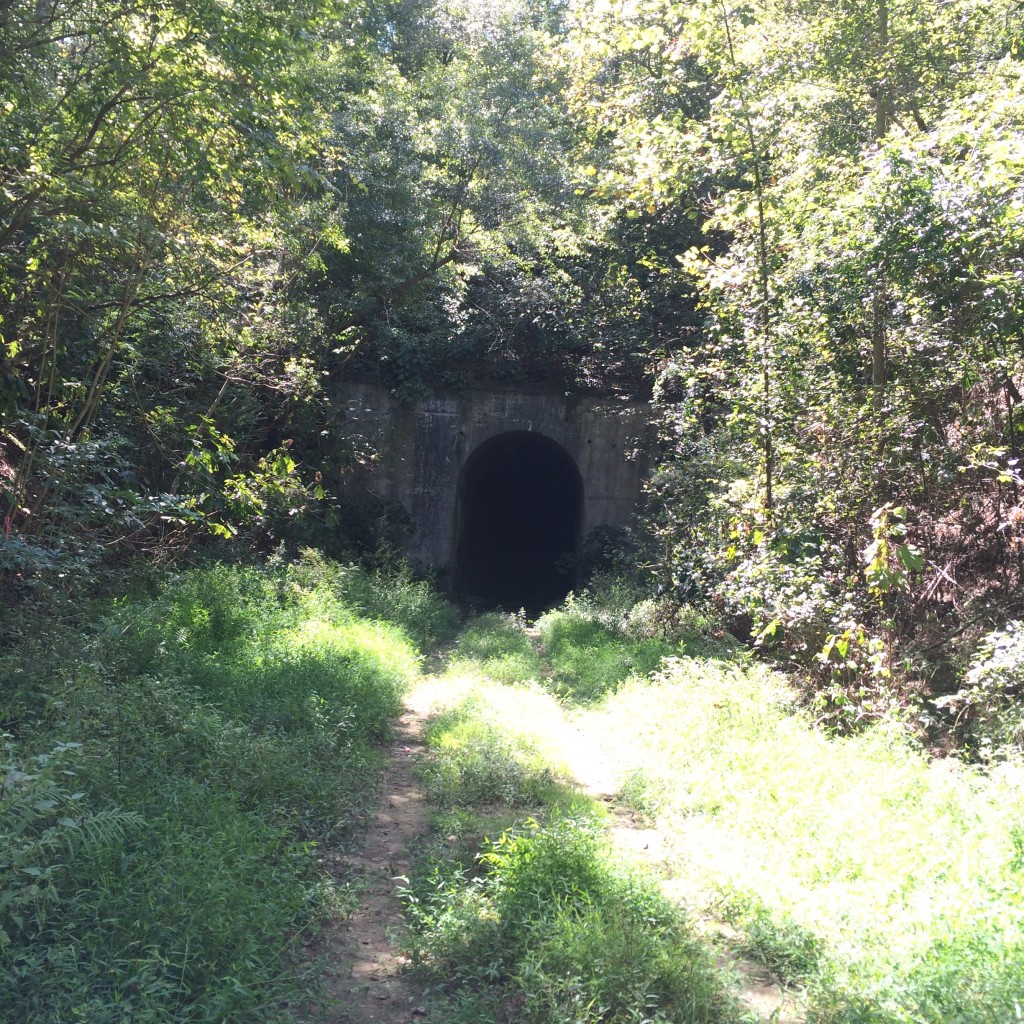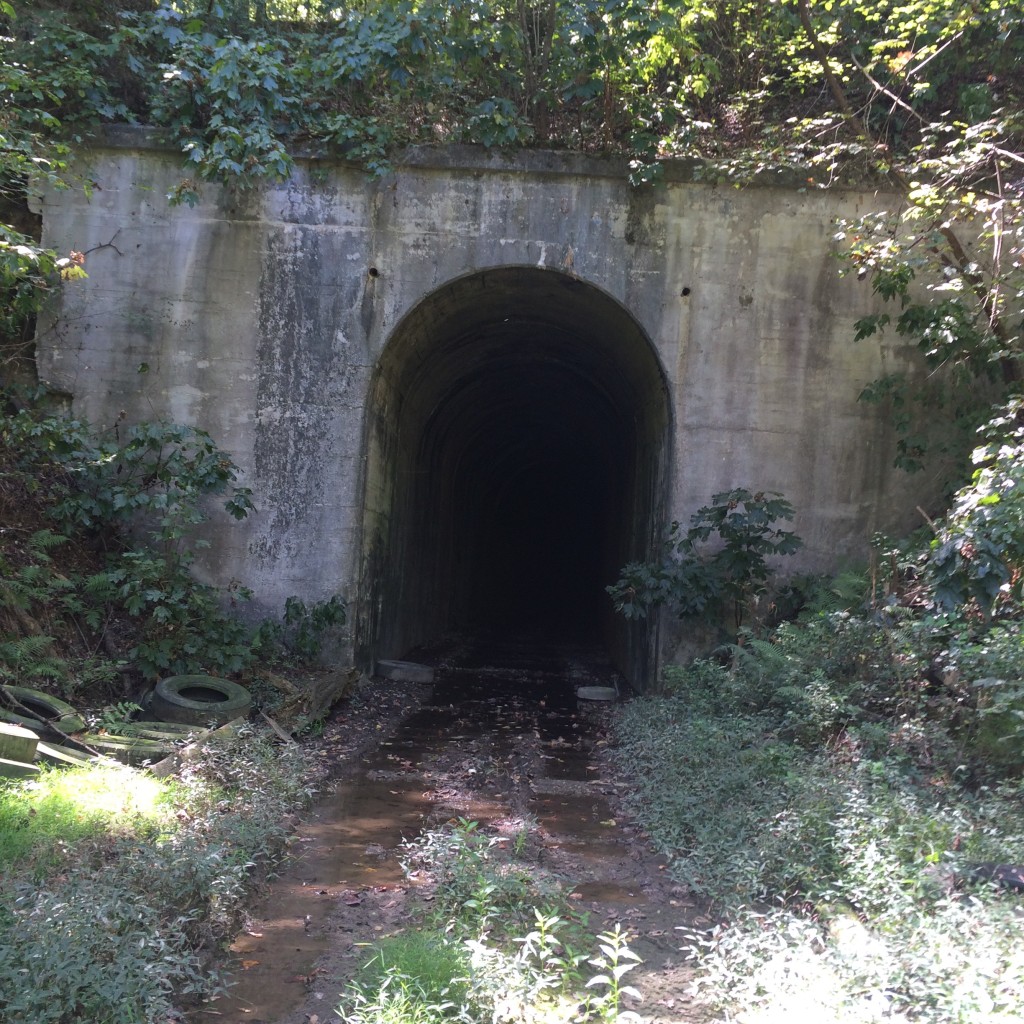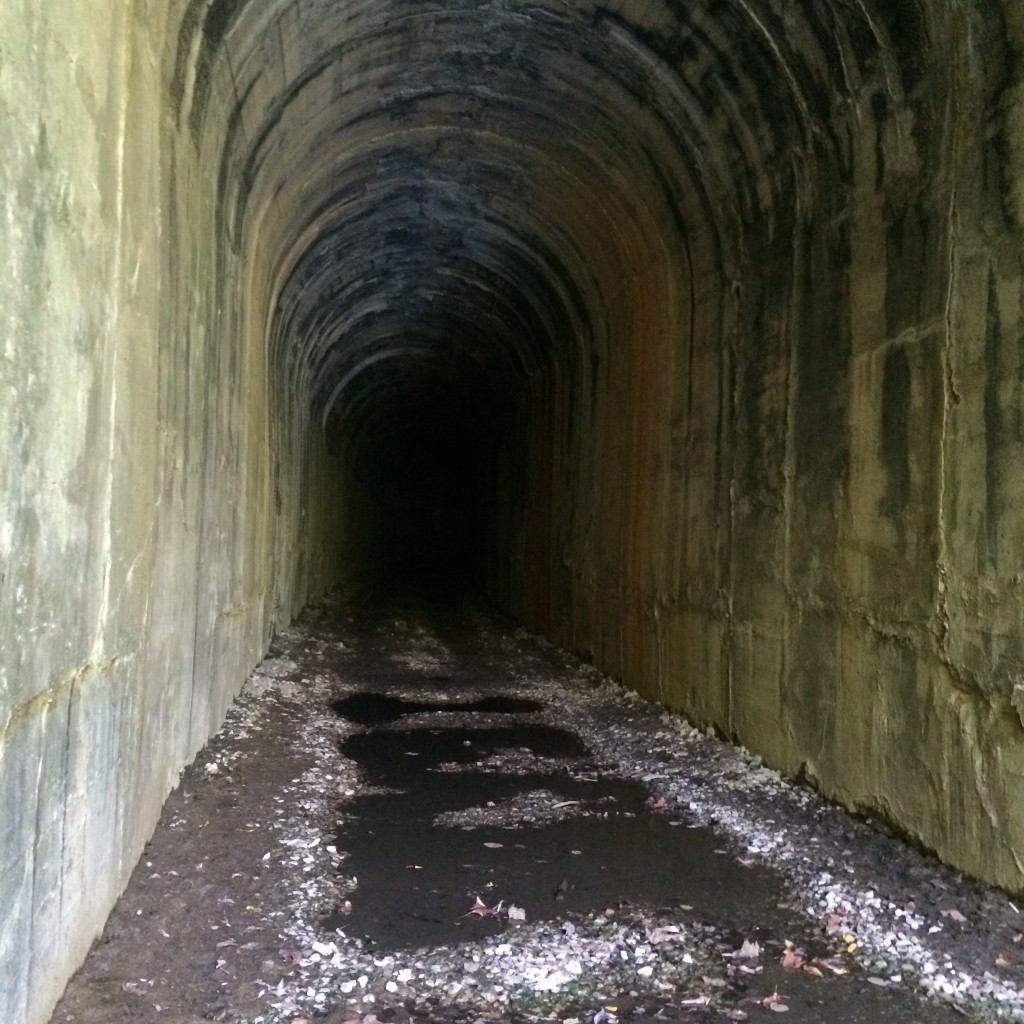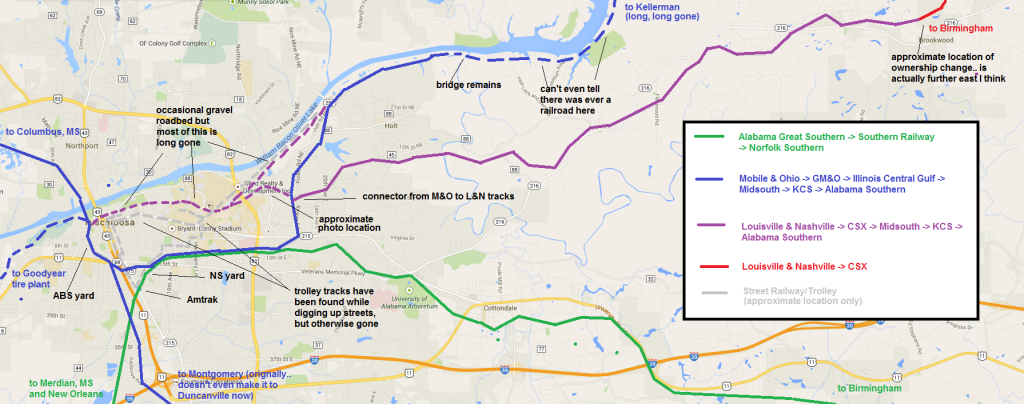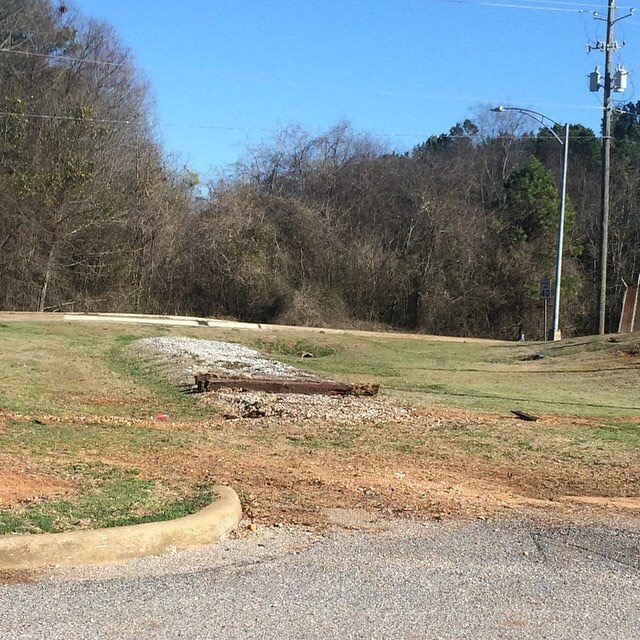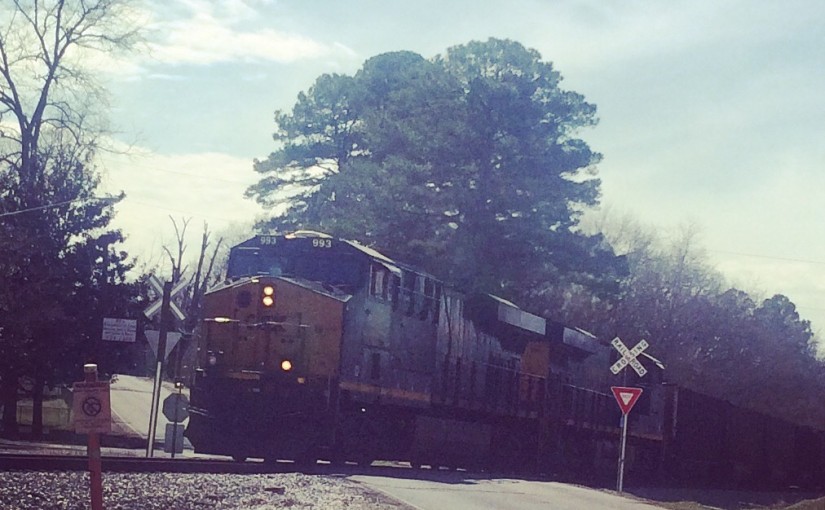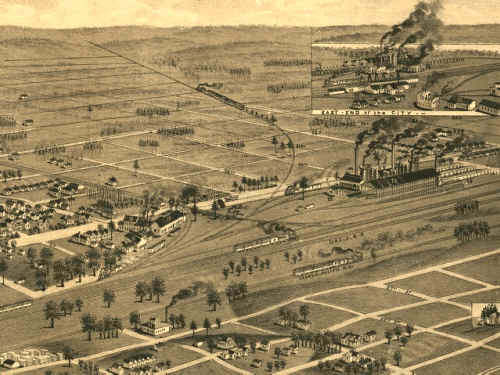Source: http://alabamamaps.ua.edu/contemporarymaps/alabama/historical/index2.html
Category: Alabama
Schambeau’s (Bayou La Batre) Commercial
I have no recollection of Schambeau’s advertising on TV, especially not a spot this long. It looks like the early 80s. The kids shown buying from the candy counter were probably my classmates.
Schambeau’s was one of the two main grocery stores in Bayou La Batre, along with rival Greers. Schambeau’s was about a mile further from our house, but we shopped at both.
Schambeau’s was more of a General Store than Greers, which was purely a Supermarket. In the last years, Crum Schambeau was heard to remark that the real competition was the Walmart in Tillman’s Corner.
Schambeau’s did not long outlive Mr. Crum, due (I’m told) to his heirs not wishing to continue running the store. Greers continues.
Bayou La Batre’s Own “Cannery Row”
When you grow up in Bayou La Batre, there are certain things long gone that you hear about from the older residents.
The railroad. The fine hotels destroyed by the 1906 and 1916 storms, never to return. The old bridge. (Twist: I remember that one, and the old Dauphin Island bridge too!)
When we would drive around the shore on Shell Belt Road, my Pawpaw would point out a location where the “Old Factory” used to be. There was not even a trace of anything that looked like a building remaining.
This map, dated 1918, shows a “Canning Factory” at the end of a railroad spur, located conveniently near to the “Oyster Beds”. I don’t remember anyone specifically saying that oysters were what was processed at the factory, but it would certainly make a lot of sense if it was.

The railroad here was the “Bay Shore” branch of the Mobile & Ohio Railroad, which operated from approximately 1899 to 1940. There is little to show of this line today, the rails having been physically removed soon after abandonment. It is memorialized by Railroad Street in the Bayou and Bay Shore Avenue in Mobile.
This (1926) map highlights the route from Mobile to Bayou La Batre:
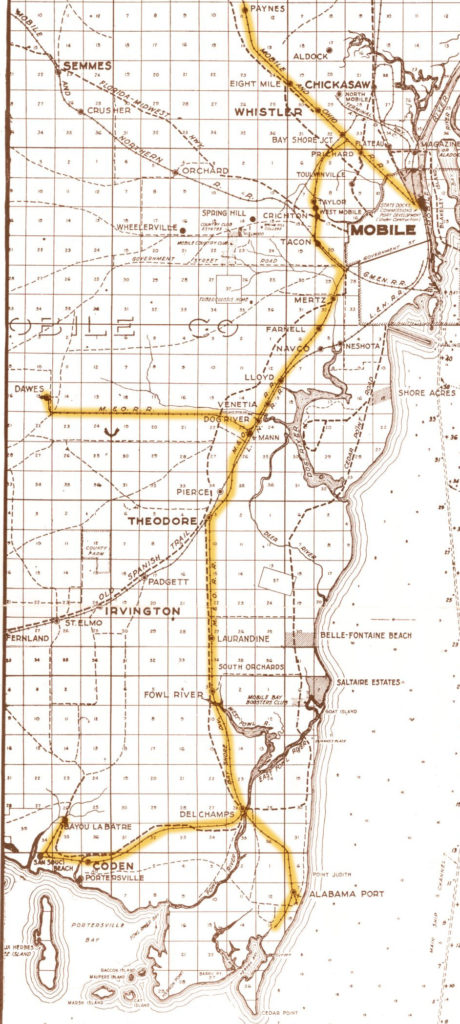
The Bay Shore Historical Society website says:
At the far western end of the wye at San Souci was the lead to the Alabama Canning Company, also known as the American Canning Company. Alabama Canning Company was located on the north end of Coffee Island, about a mile south of the junction at San Souci. It was on this track that the trains would head down first, then back up through the wye toward Bayou la Batre.
The 1918 map disagrees about the factory being on Coffee Island, and I’m inclined to side with the map. An island location would have required the railroad to build a mile-long trestle over the bay. This does not fit with any description of this railroad that I’ve ever heard of before, and would have been a literal “bridge to nowhere”.
It seems more reasonable that the factory was located on the mainland.
At the approximate location of where the “Old Factory” was said to be, there is still a dirt “road” off from Shell Belt Rd through the salt marsh, leading towards the shore of Portersville Bay. It goes to a point that naturally sticks out into the bay. It can clearly be seen on modern satellite images:
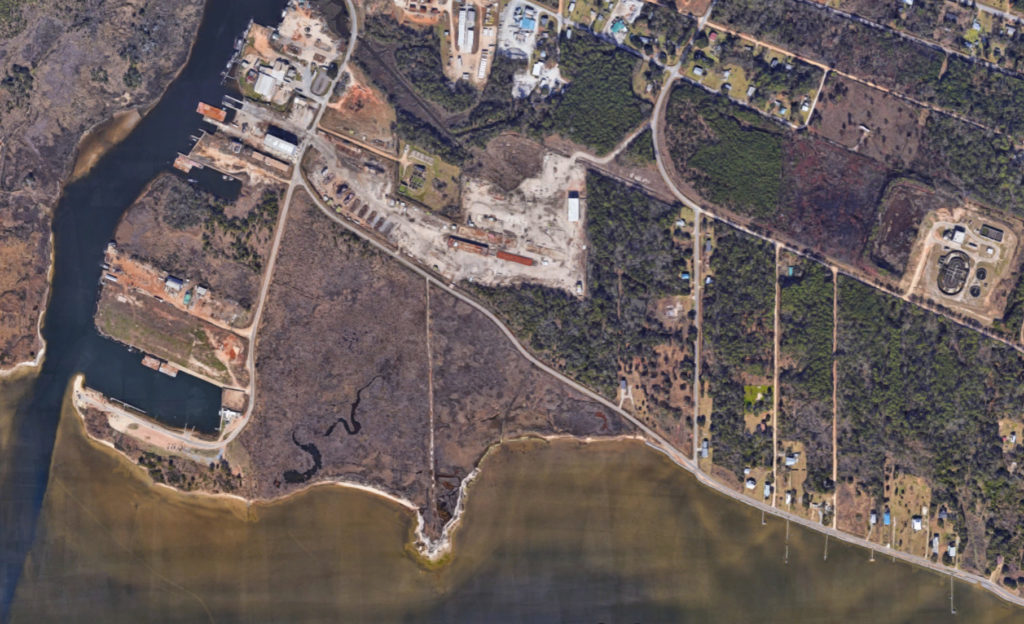
This is what it looks like in Google Street View (and in real life too!):
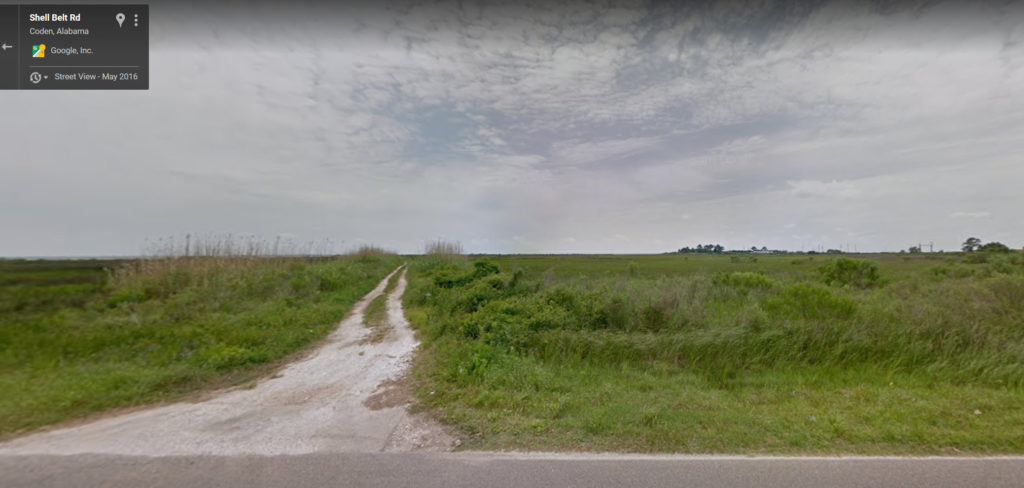
It is most consistent with the old map if this “road” is actually the railroad right-of-way. Here is the satellite image with the guessed route of the railroad tracks highlighted in yellow:
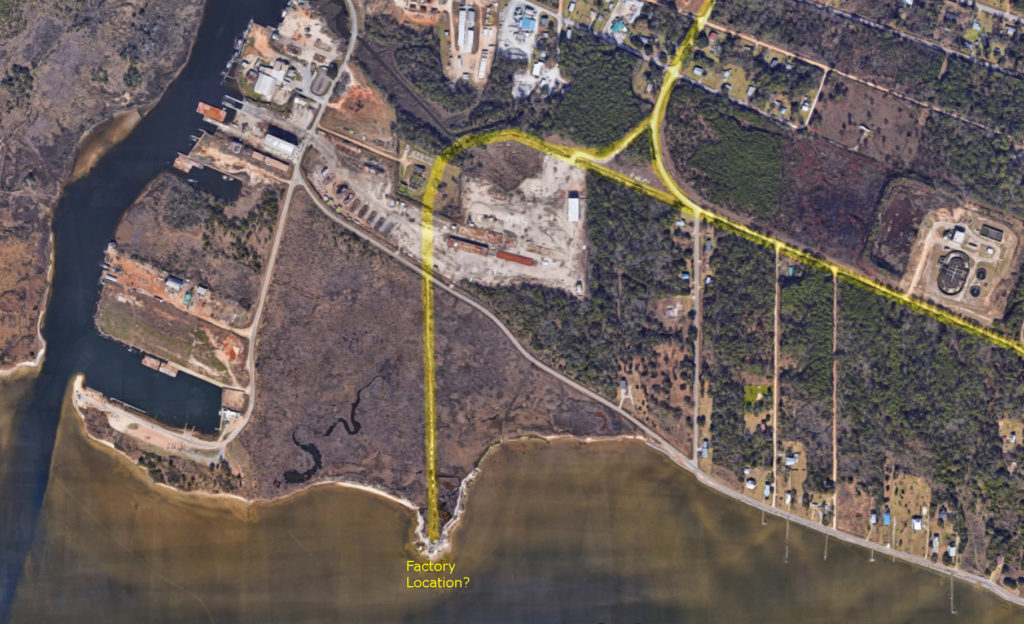
The real revelation happened when I began searching for more info on the “Alabama Canning Company”.
It turns out there are a lot of pictures of this place, located in the National Archives and the Library of Congress!
This photo shows oysters being unloaded onto the dock. It looks like they had a large pier running out into the bay, with railroad tracks utilized for wheeled oyster baskets. The factory in the background looks like a sizeable operation. It must have been the biggest industry in town at the time.
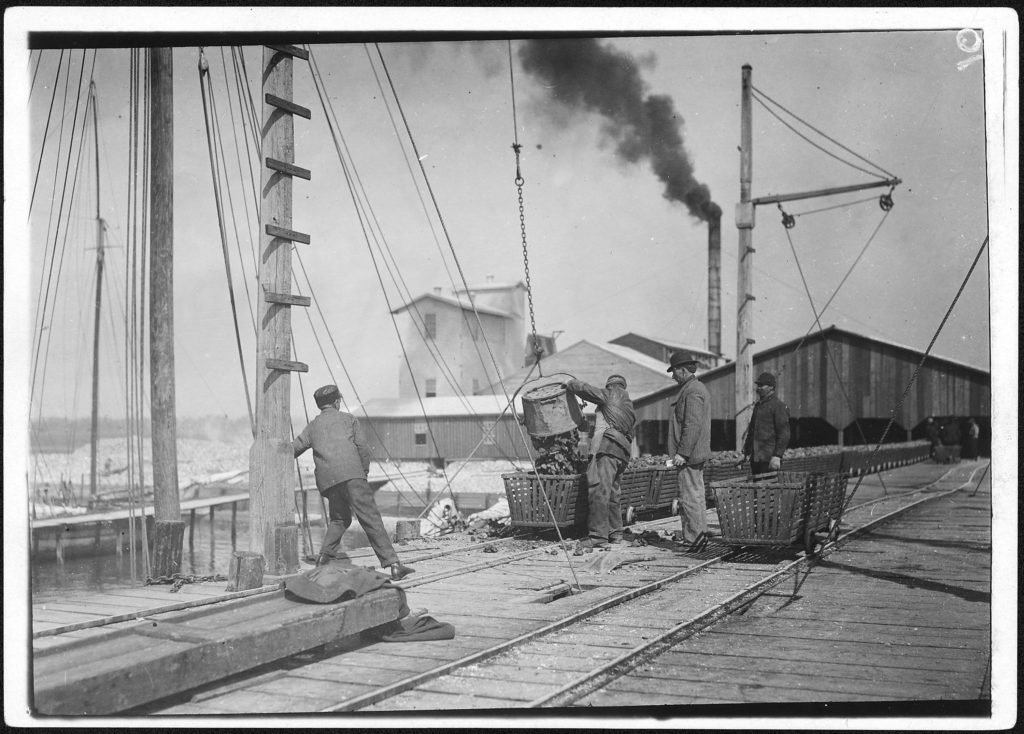
Here we see the whole thing as it looked from out on a boat in the bay:

Many of the photos show very young workers in the factory and on the boats. This was the early 20th century, the era of child labor.
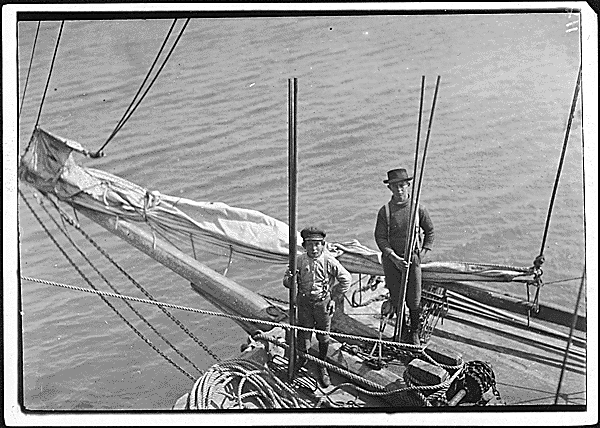


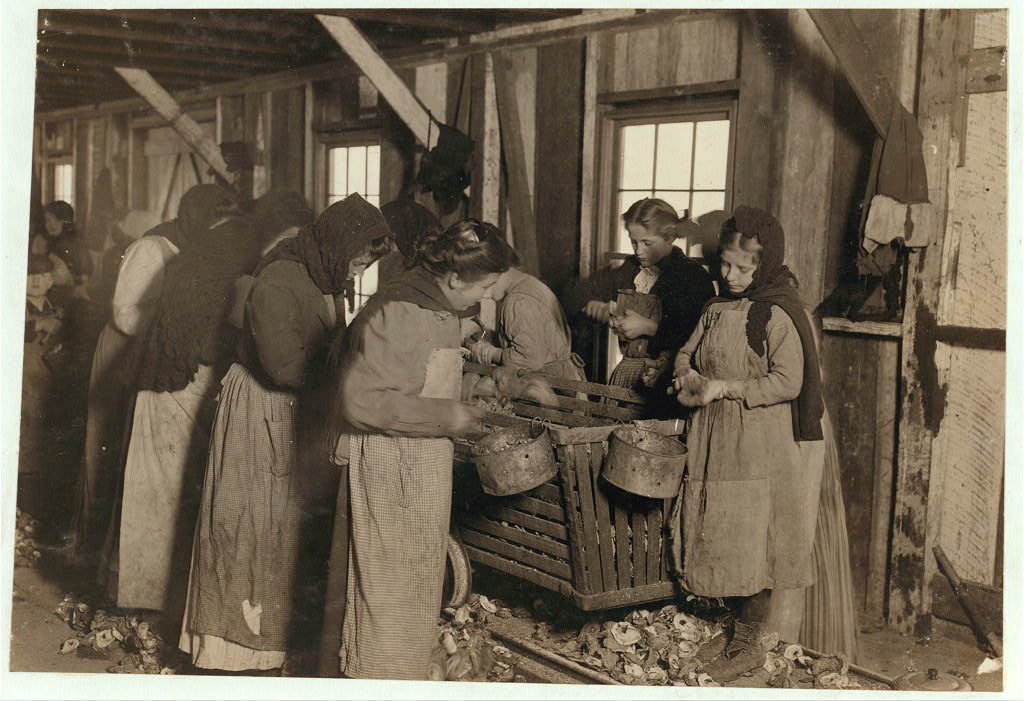

The work was seasonal, with many families coming to town only during the cooler months when oysters were in season. You can see in the photos almost everyone is dressed for cooler weather. Many of the workers were also immigrants, as the captions mention some children being unable to speak English. From the Mississippi Gulf Coast Museum of Museum of Historical Photography website:
The [labor shortage] problem was resolved initially by bringing in Eastern European immigrants known as ‘Bohemians’ from the Baltimore, Maryland canneries. The Baltimore people traveled in special railroad cars from their homes in Baltimore to work the canneries during the winter oyster season along the coast. They lived in factory-owned camps near the canneries, and the children rarely attended local schools. Some of the Baltimore families stayed on after the oyster season.
We can assume the hiring practices established in Biloxi were also followed in Bayou La Batre.
It turns out the reason all of these 100-year old pictures from Bayou La Batre are part of the national historical record, is because they were part of a famous series taken by Lewis Wickes Hine. Lewis Hine is an unsung hero of American labor relations, risking his own safety to end the practice of child labor in this country.

In 1908 Hine became the photographer for the National Child Labor Committee (NCLC), leaving his teaching position. Over the next decade, Hine documented child labor, with focus on the use of child labor in the Carolina Piedmont,[3] to aid the NCLC’s lobbying efforts to end the practice.[4] In 1913, he documented child laborers among cotton mill workers with a series of Francis Galton‘s composite portraits.
Hine’s work for the NCLC was often dangerous. As a photographer, he was frequently threatened with violence or even death by factory police and foremen. At the time, the immorality of child labor was meant to be hidden from the public. Photography was not only prohibited but also posed a serious threat to the industry. To gain entry to the mills, mines and factories, Hine was forced to assume many guises. At times he was a fire inspector, postcard vendor, bible salesman, or even an industrial photographer making a record of factory machinery.[5]
So here we have a connection to historical events of national importance, right there in Bayou La Batre, and all that’s left of it is a dirt path through the marsh grass and scattered recollections of an “Old Factory”.
Hine is also the photographer of a very well known series on the construction of the Empire State Building.
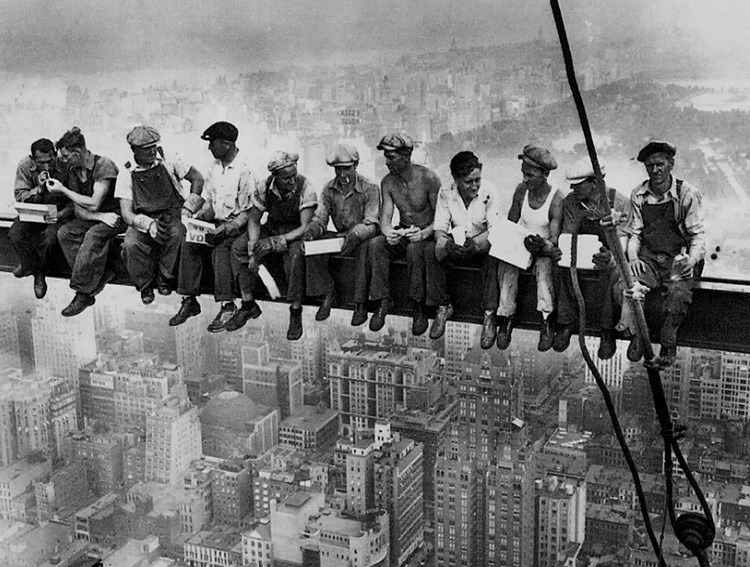
So when was this factory built, and whatever happened to it? The Bay Shore website says:
Below is a photograph taken before the hurricane of 1906, showing the company tracks on the west side of the building. The photographer is facing south, toward Portersville Bay.
The buildings seen in this image were either heavily damaged, or destroyed, in the 1906 hurricane, and the company either elected not to rebuild, or was financially unable to. At a later date (unknown) this location became the Dunbar & Ducate Factory. Dunbar & Ducate was later destroyed by a boiler explosion which claimed the lives of several employees.
“Dunbar & Ducate”, (or DuKate) had already taken over by the time of Hines’ photos in 1912-1913 (and indeed some of his captions refer to it as such).
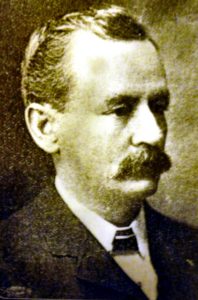
The Biloxi Historical Society lists a number factories owned by several firms involving the DuKate family, including “Dunbars, Lopez, & Dukate Company“, in Alabama, Mississippi, and Louisiana. It appears that it was often called the “Alabama Canning Company” even when it was owned by DuKate.
Julian Lee Rayford, writing in 1956, describes a world already long gone, including a “Big Factory” owned by “Dunn, Barr, and Ducate”.
GEORGE BRYANT told me about the factories
in Bayou la Batre.The factories fall into two classes. First, the
factories of 1915, and a few years later. And,
second, the factories of today. There is little con-
nection between the two. True, the factories have
always canned shrimp and oysters, but there is a
distinct contrast between the periods.Pure Food Laws have cleaned them up, and
now, everything is peaceful and quiet in the fac-
tories. Government inspectors stand on constant vi-
gil making the pickers maintain purity and quality
in the products.After 1906, the factories lined the Bayou.
There was the Union factory, operated by the
Union. There was the finest and largest, the one
run by Daughdrille. On the coast, was the “Big
Factory,” controlled by Dun, Barr and Ducate. And
there was the “Green Factory,” so called because of
the color used on the outside of the building. All
along the Bayou were the picking sheds, which sent
their products to the larger establishments to be
packed, or, canned.
An article in the New Orleans Times-Democrat, April 7 1910, mentions a factory being constructed by this company in Bayou La Batre:
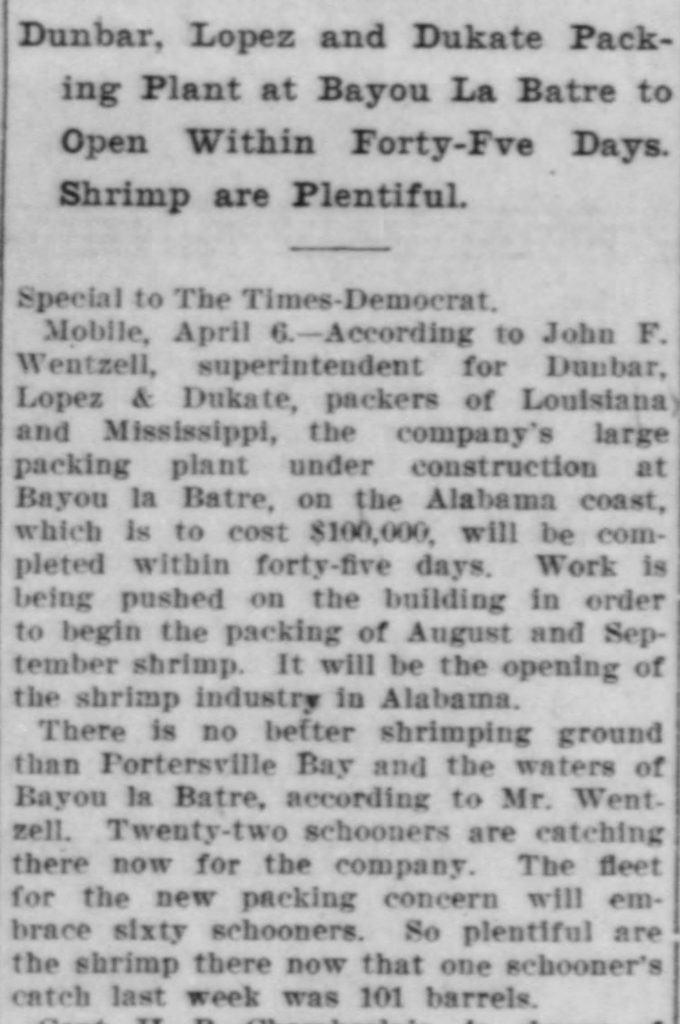
The John F. Wentzell mentioned here is probably related to Wintzell’s Oyster House founder J. Oliver Wintzell, as well as the Wintzell family of Bayou La Batre.
The factory is described as packing shrimp. It is not clear if this was the same facility as the oyster plant shown in the photos, or a different plant also located in Bayou La Batre.
I cannot find any information about the existence of the Alabama Canning Company earlier than this. It is possible it operated under a different name before DuKate took it over, if it actually existed before 1910.
The plant survived and was repaired after the 1916 storm:
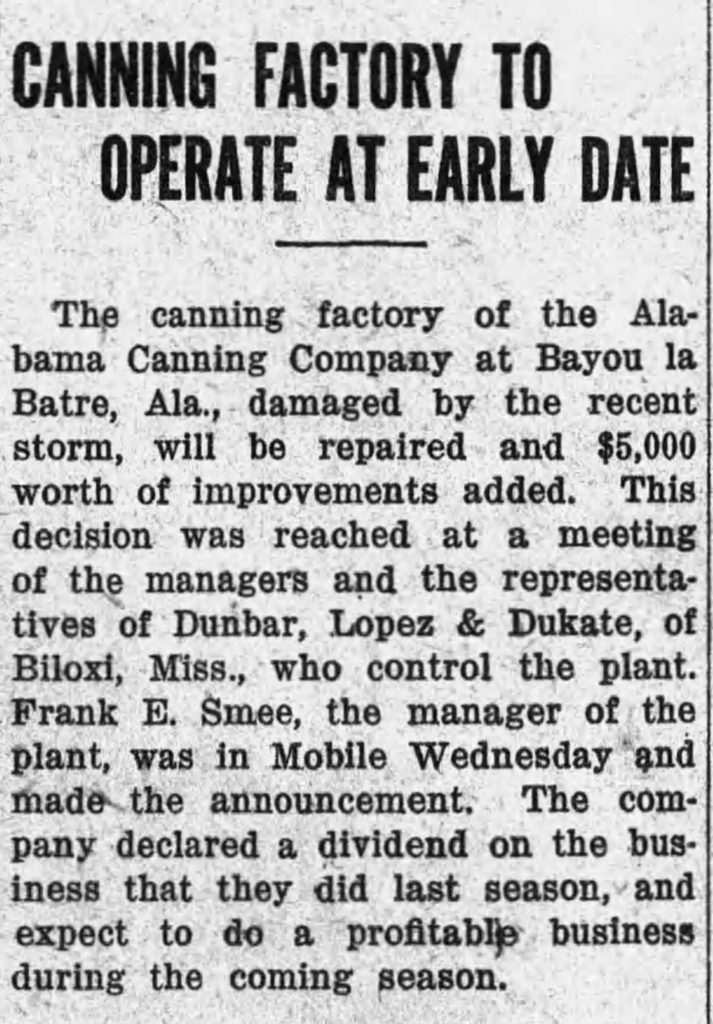
I can only find one other page about an explosion, the Find-A-Grave page for Robert Walter Cox who died on August 16, 1923 when an ammonia tank exploded in the ice plant of the cannery. It reads like a newspaper article, but there’s no citation and I cannot find the same story anywhere else.
EXPLOSION KILLS ONE AND INJURES TWO AT ICE PLANT
Ammonia Tank Blows Up At Bayou La Batre, Killing Robert Cox and Wrecking Plant
Death injury and heavy property damage resulted form a violent explosion at the ice pant of the Alabama Canning Company at Bayou la Batre Thursday night. Robert Cox, 40 years old, frieman at the plant was almost instantly killed and two other persons, Willie and Aime Castello, father and son, recieved serious injuries. The disaster occurred when an ammonia generator exploded, wrecking the one-story structure. The loud noise which accompanied the explosion attracted the attention of people throughout the community, many of whom hurried to the scene.
Cox was discovered in a dying condition outside the boiler room a few minutes after the generator exploded. The younger Castello was huried to the roof of the building from which he was rescued by persons who rushed to the plant. Willie Castello, the father, is an engineer at the plant according to information received in Mobile. His son is tankman at the ice plant.
Shortly after the accident a Mobile physicain was summoned to treat the injured. The small casualty list was apprently attributable to the fact that only a few employees were on duty whe the explosion occurred.
Perhaps this explosion was too much for the Big Factory to come back from, and put them out of business. Perhaps the Pure Food and Child Labor laws had made the business unprofitable. Or maybe decreasing supply due to overfishing. Or a combination of all these things.
By the time of this 1943 map, the railroad is abandoned, the spur track for the factory is already just a dirt road, and the there is no indication building where the factory would have been.
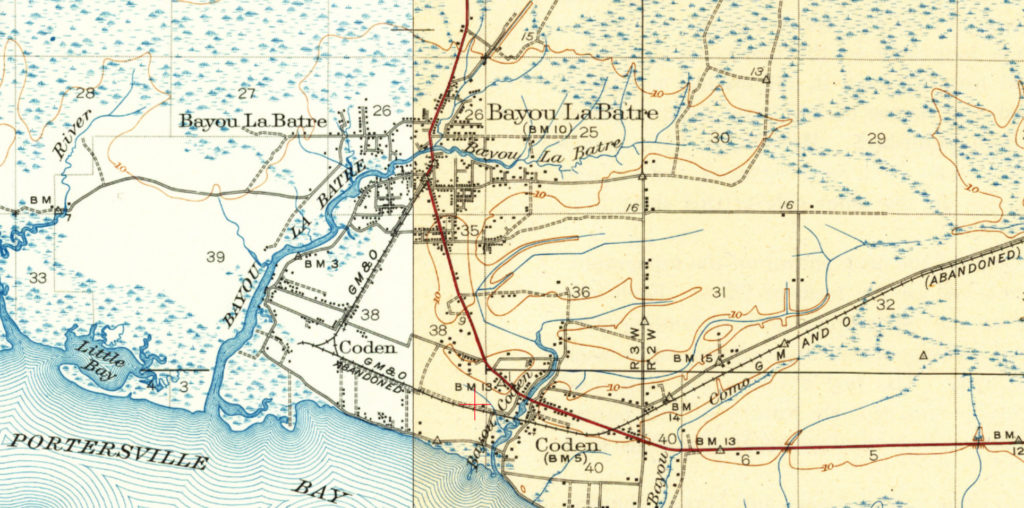
It is also gone on this aerial photograph from the 1940s, where things do not look terribly different from today:
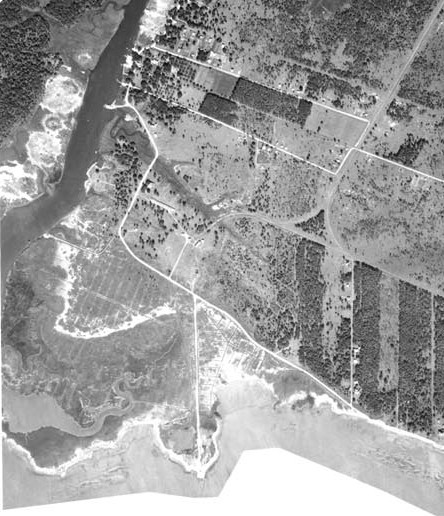
In the 20 years from 1923 to 1943, all trace of the Old Factory has vanished into the sea and sand.
Tunnel Springs, Alabama
Near the town of Tunnel Springs in southwest Alabama is a feature normally reserved for more mountainous areas: a railroad tunnel, abandoned for years, and relatively easy to find.
The tunnel is located up the abandoned line past the north end of what is now the Alabama Railroad. Wikipedia gives us the date of construction of the tunnel as 1899:
The route of the Alabama Railroad was originally constructed over several years (between 1880–1901) as the Pensacola & Selma Railroad and quickly became a part of the Louisville & Nashville Railroad network. The original line proceeded north from Corduroy, Alabama to Selma, Alabama. That portion of the line was abandoned by the Seaboard System prior to the merger with CSX in 1986. There was also a L&N branch that went to Camden from a junction just northeast of Corduroy that was abandoned prior to the merger into the Seaboard System in 1986. The remainder of the line north of Peterman, Alabama was abandoned approximately 1994 to include an 800+ foot tunnel built in 1899 located at Tunnel Springs, Alabama.
This should not be confused with the similarly-named and situated Alabama and Gulf Coast Railway, the former Frisco line only a few miles to the west.
As I’m always looking for things to do on that long stretch of Nowhere, Al, between Mobile and Montgomery, I decided to go find it. After looking at some topo maps, I got a pretty good idea of where it was.
This link in Google Maps gets you to a location where a trail that used to be the tracks crosses the road:
From there, I walked south along the railroad. There were no ties or rails left on this part of the railroad, making a smooth walk.
Obviously by the ruts in the ground, people drive off-road here a lot, so if you have a 4×4 you could just drive right to the tunnel.
Getting close to the tunnel:
Nearing the tunnel entrance, the trail gets pretty muddy. You have been warned.
This picture, you can kind of see how much water is right in front of the tunnel.
It’s actually drier inside the tunnel itself.
I walked far enough to see daylight from the other end, and then turned around.
The ceiling is home to a large number of bats. The sound of them chirping is quite loud, and the whole place smells like guano.
1926 topographic map of Tuscaloosa
Screenshot of part of a PDF downloaded from the USGS map store. Click to enlarge.
Notice an additional rail line crossing the L&N, that I forgot to include on my map that I made with MS paint. This was the electric street railway. I have since edited that map to show it.
Tuscaloosa rail map
The explanation I tried to give about the abandoned tracks in Tuscaloosa in my last post probably makes more sense if you look at this map. Click the map to enlarge it.
For reference, this is the photo of the “approximate photo location”:
The main reference for the location of the street railway is here.
Again with Alabama train pictures
A last-minute one-night trip to Tuscaloosa afforded me the opportunity to do some rail fanning on the way back, mostly CSX in the Birmingham area.
I did not go looking for trains in Tuscaloosa itself. This is the only photo taken in Tuscaloosa, and it shows the remaining ballast and ties of the L&N line from Birmingham to Tuscaloosa. This was taken near the city water works along Jack Warner.
Rest assured there is still plenty of active rail in Tuscaloosa but we won’t be visiting it today.
Now in between here and Birmingham a couple of things happen. This line crosses the Alabama Southern shortline, which operates the former ICG eastward from Mississipi into Alabama. Eastward from that crossover, the dead L&N line goes active and used by Alabama Southern to send trains to CSX in Birmingham.
At Brookwood, the track comes under CSX ownership, the direct successor to the L&N. This is the “Birmingham Mineral subdivision” and it serves the still-active mines in that area.
This is a coal train that I caught next the the Lowe’s store off of I-20/59 in Bessemer, where the line from Brookwood joins with tracks that make a loop around the western side of Birmingham.
Here you can see another train waiting for this one to pass:
I was able to stay ahead of the train for a while and caught it again a couple of times.
Now back to downtown Birmingham. I got Amtrak 19 as it came into the station, and an intermodal train that passed immediately after.
These are views taken from the 1st avenue north viaduct that overlooks the 27th street interlock. I stood out on that bridge long enough for three trains to go under it before leaving Birmingham.
University of Alabama, Wilson Hall (Demolished 2011)
These seem to be the only photos I have from when I explored this building shortly before it was torn down. I thought I took more.
Wilson had been used as a lab for studying children, as there was a large play room with one-way mirrors to watch the kids play. I don’t seem to have saved any photos of that.
Headless teddy bear see-saw in the basement:
One of the heads:
This toilet looked like people had been using it long after it had been disconnected from water:
The attic. Now you know where my twitter profile picture is from:
More Birmingham
When I said “it’s almost like it was designed by a railfan”, that may or may not literally be the case, but the downtown street grid was planned around a “railroad reservation”, as Birmingham was laid out in the 1870s at the height of railroad importance.
As the “Birmingham Wiki” says:
The Railroad Reservation is a plot of land, 1000 feet wide by 4,780 feet long in the center of Birmingham‘s street grid, set aside in William Barker‘s original plat of the city for use by the railroads and related industries.
The tracks within the railroad reservation remain active today, giving people in Birmingham a rare opportunity to engage in trainspotting or benching in the midst of the downtown core.
This “bird’s eye view” drawing from 1885 shows the area around Sloss Furnace. Just look at those happy little trains. The railroad lines are recognizable. The train nearest the top of the picture is on what would now be the CSX, the middle train is on the NS, and the bottom train is on a segment of track that no longer exists but is continuous with the extant Alabama and Tennessee River. Most of the land is still empty, but the street grid is already laid out.
That image is from Birmingham Rails, which has a lot of interesting maps and other images if you follow the links.
What follows is a smattering of pictures taken at various places around the city.
NS SD40-2 on the north side of town with an obviously ex-BN green one with spraypainted change of ownership:
The tail end of a CSX train passing over Graces Gap, which is where northbound trains cross over Red Mountain into Birmingham proper. This train has already passed the CSX control point called “Grace’s”, which is slightly south.
Caught the lead ES44AC of another train from the same overpass:
I managed to beat that train downtown, and catch it again from the parking lot of Carrigan’s Public House.
A different CSX train, this one showing the contrast between the “Bright Future” and “Dark Future” (fan nickname) paint schemes:
UP power on NS, taken down under the Richard Arrington Blvd bridge.
Downtown Birmingham Railfanning
Downtown Birmingham is not only better-preserved than downtown Atlanta, it is also much easier to watch trains. It’s almost like they let a railfan design the place.
Viaducts
Birmingham has its own equivalent of Atlanta’s “gulch”, sort of. NS and CSX run right beside each other through the very center of town. Both railroads are double-track, and there are additional sidings and such, so a fairly wide path through downtown is devoted to rail.
Birmingham’s downtown street grid is (as in Atlanta) grade-separated from the railroads, except that in Birmingham many of the surface streets go under the tracks rather than uniformly over. The freeways and a few surface roads go over the tracks on viaducts that provide a good view of the trains below.
Birmingham has not built any structures completely over the top of the tracks, as Atlanta has. Therefore the view from the viaducts relatively unobstructed.
The bridges on 22nd street and Richard Arrington Blvd (which occupies the place of “21st” street in the grid) have curbside parking spaces on the bridge, so you can pull your car over right in the middle and stand next to it waiting for trains to come by.
You shouldn’t have to wait long, because these viaducts span main lines of both NS and CSX. (Birmingham’s other Class 1, BNSF, is a topic for another day)
The 24th street viaduct provides no such parking, and the sidewalk is only on one side of the road, so it is not as good as the others.
This is a view looking southwest from the Arrington Avenue viaduct. To the right of the tracks in the distance you can see the platforms of the Amtrak station. These two photos show two trains that went by in rapid succession, you can see the end of the first train still in the second picture.
This is looking northeast from the same place (and same train). Mountains loom ominously on the horizon.
Some blatantly “instagrammed” pictures of the same trains. You can see the Sloss Furnaces pretty clearly in the background of these.
Sloss Furnaces
Speaking of which, before getting back to the rail pictures, let’s throw in a few of the Sloss site itself. If you don’t look at these and say “I want to go to there“, then I don’t really understand how you like trains either.
27th Street Interlocking
As shown on the map above, this is a major intersection of NS and CSX lines. In spite of its name, it not directly viewable from 27th Street. I got a good view of it from the extreme western end of the Sloss property.
The shortline Alabama and Tennessee River also comes into play here, but I saw no sign of their trains.
“Emergency release instructions” for both roads :
An NS train is about to cross the double CSX tracks, with the downtown skyline in the background.
A train approaches on the CSX with a BNSF unit in the lead:
The Crescent train 19:
Anoether NS train waits under the 1st Avenue North viaduct before proceeding. The viaduct itself might have provided a good overhead view of all this stuff, had I managed to find a place to park near its approach.
Railroad Park
At the other end (southwest) of the downtown corridor shared by NS and CSX, lies Railroad Park. It is a nice park, but I think if you are really out just to see trains rather, then you will get a better view from the viaducts.
Easy Livin’ in Irondale
These last were not taken in downtown Birmingham at all, but out in the suburb of Irondale where the NS tracks enter Norris Yard. Here these is a covered wooden platform beside the tracks with benches and picnic tables, so you can just sit in the shade and relax as the trains roll by.
I did drive around Norris as much as possible without entering obvious NS property, but I didn’t really feel like stopping anywhere to take pictures, so these are all taken from the platform. The sun was pretty low by this point, as can be seen in these pictures.
